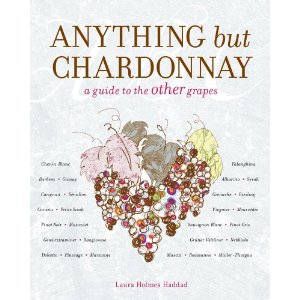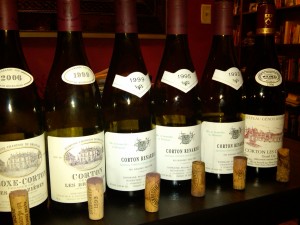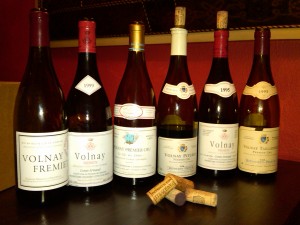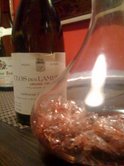Before reviewing the recent Burgundy tasting, I want to start off by encouraging anyone curious enough about wine to be reading this blog to JOIN A WINE CLUB. I joined the club I’m in over 2 years ago and the core of the club is still intact. We have a real nice group of people, and while pooling money, we are able to sample some of the great wines of the world.
Speaking of great wines of the world, Burgundy wines (the red made entirely of Pinot Noir) are said to be some of the finest in existence. And of the various communes, Vosne Romanée, together with Chambolle-Musigny & Gevrey-Chambertin, are said to make up the finest Burgundy offerings.
Finishing our tour of the various communes, the group focused on some wines from Vosne Romanée. We tasted 7 wines, 2 village level, four Premier Cru (1er Cru) and one Grand Cru wine.

(2 bottles are mysteriously missing)
The tasting was exciting & educational and a terrific ending to our series of RED Burgundy wines. Up next – Chablis!!!
A quick and interesting (to me at least) note is that we tasted these bottles the first time around immediately after opening them. In the past we have decanted, but we (primarily our host) decided not to decant and to taste right after opening. I did not have a problem with this and found plenty going on in each of the wines during the first taste. HOWEVER, I re-tasted all of the 7 wines and found that EACH AND EVERY ONE was showing different characteristics the second time around. An assessment that was shared by other group members. And while this is not exactly a shocking realization for wines reputed to be the most complex in the world, it was nonetheless quite an exciting revelation for me, and helped me to better grasp the allure of great Burgundy wines.
The first wine we tasted was a 2006 Domaine Mugneret-Gibourg, village level wine. This was the youngest wine we tasted, yet it had a unique aroma I really enjoyed. I found cola syrup smells on the nose. While cola is not an unusual aroma for wines, this was different – it seemed to be more concentrated and reminded me of frozen cola pops. The flavor one gets when sucking the syrup from the pop, that strong syrupy taste – that is what I picked up on. Otherwise, this light ruby wine had a stoney-mineral thing and subtle fruit, to compliment its round feel and medium long finish.
The 2004 Domaine Robert Arnoux, the second village wine, was clear pinkish-garnet-brick in color. A little more faded then what i would have expected from a 2004 at this point. It had a lot going on. Aromas ranging from red berries and wet leaves to cola and tobacco. Some others picked up on what they considered to be undesirable attributes in this wine, but aside from a touch of heat, I thought the balance between berries, acid, minerality and finish made for a very nice wine.
The 2004 Domaine Hudelot-Noellat “Les Beumonts” was the first 1er Cru wine and the first of two from this Domaine. This clear ruby to garnet wine black berry, earth and wet leave aromas. On the palate was a touch of heat, with pleasant cherry cola and tart berry flavors. It had a nice long finish. This was the only wine where I wrote a note the second time I tasted it as I found the aroma to be unusual – PICKLES. Others in the group picked up on the pickle smell, so in this particular case I knew I was not crazy.
The fourth wine was the Domaine Hudelot-Noellat “Les Suchot” 1er Cru. Made by the same producer as the previous wine, the Les Suchot is made from 70 year old vines while the “Les Beamonts” is made from 35 year old vines. The Les Suchot had a salmon/orange/garnet like color with a whole lot of funk on the nose. Wet leaves, canned vegetables, earth and cooked berries were just some of the aromas. On the palate this wine showed under-ripe fruit (very different from its cooked fruit aroma) with a lovely acidity and a very clean, soft mouth feel. It had a medium long finish.
Stepping back a few years bring us to wine #5 – the 1996 Domaine Robert Arnoux “Aux Reignors” 1er Cru. This orange/brick wine had begun to throw some sediment, and had a complex nose with cola, funky earthiness, and some subtle fresh berry. The palate followed through with cola and tart berry flavors, a bracing acidity and a velvety mouth feel. It had a pleasant medium to long finish that i thoroughly enjoyed (though if I remember correctly others were less enamored by).
I can’t say that I recall why we did things in this order, but the second to last wine of the night was the 1999 Domaine Meo-Camuzet “Aux Brulée” 1er Cru. Apparently this wine carries a retail price somewhere near $500. Thankfully we did not pay that. And frankly, for comparison sake, i would say that for most of us any of these more affordable options (relatively speaking of course) would present fine alternatives. This wine had a youthful dark ruby color with some small sediment. Given its youthful color I expected more fruit, but found this wine (at least the first time around) to be more mineral driven. Lots of chalky, stoney minerality going on. There was a touch of funk and some interesting mintiness as well. On the palate this wine showed its fruit. The red berry flavors were ripe, different from some of the under-ripe or cooked berry flavors of others. And it had a very nice and long finish.
Our 7th and final wine of the night was the Louis Jadot (negociant) 1999 Romanée-Saint-Vivant GRAND CRU. Negociant Jadot makes a lot of wine all across the quality spectrum. Some group members were not optimistic about this wine given the negociant’s checkered reputation, but I attempted to taste this wine with as open a mind as possible – if for no other reason than its status as a Grand Cru Vosne Romanée. And while I was not blown away by the wine, it was quite lovely.
It had a light pinkish ruby color and a very subtle, possibly closed nose. My notes from the taste read as follows: “mineral, nice lite red fruit, round, nice, but…”. As you can see, I was expecting more. Again, a lovely wine, but…no earth shattering WOW, this is amazing, I can now die and go to H… The wine by the way had a medium to long finish.
Happy BURGUNDY wine tasting!
WTG








